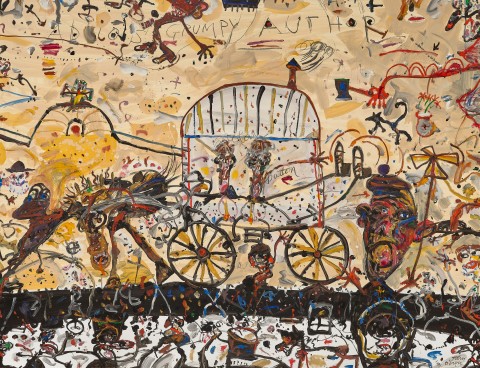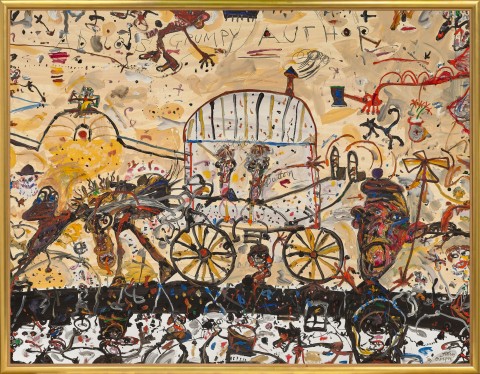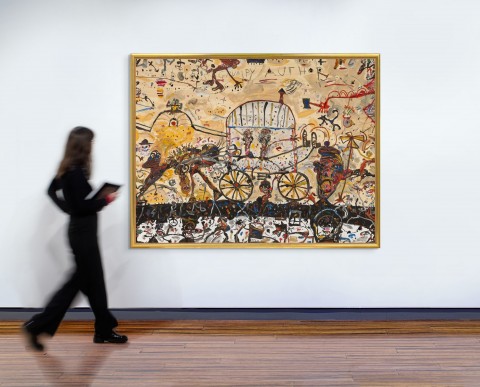(1928 - 2023)
John Olsen
Adios grumpy author [Patrick White and the Gypsy Caravan], 1991
oil on canvas
Australian Galleries, Melbourne (label attached verso)
Private collection, Melbourne, acquired from the above 6 November 1991
John Olsen, Australian Galleries, Melbourne, 28 October – 20 November 1991, cat. 2 (as ‘as ‘Adios Grumpy Author’)
In the late 1980s and early 1990s, as he entered a new phase of his life, John Olsen embarked on an unprecedented period of existential contemplation, ruminating on the peripatetic trajectory of his life and, more poignantly, the nature of mortality and artistic legacy in general. The large paintings that emerged from this period of soul-searching were characterised by the poetic spirit and dark colouration of the Iberian Peninsula, a region that had held Olsen in thrall since his first sojourn there more than four decades earlier. Adios, grumpy author, 1991, belongs to an important subgroup of works within this period featuring celebrated artists and authors travelling in Spanish gypsy caravans. Full of absurd humour and activity blurring past and present, these works commemorated important figures in Olsen’s life and career, uniting them with the caravan as symbols of creative and spiritual liberation. The grumpy author gaily farewelled in the title of this painting is the Australian novelist Patrick White (1912 - 1990), who, in Olsen’s narrative, has been unceremoniously and posthumously ejected from the jolly caravan.1
In December 1987, Olsen made a trip back to the remote village of Deià, Mallorca – a coastal settlement untouched by tourism and preserving peasant life. While the main purpose of his travel was to visit the resting place of Robert Graves, an English poet whom he had befriended there many years before, Olsen renewed his fascination with artists such as Goya, Zurbarán and Picasso, and immersed himself in the writings of revered poet Federico García Lorca.2 The fascination with and respect for gypsy culture in Lorca’s ballads fed directly into Olsen’s suite of works produced upon his return. In 1991, Olsen explained, ‘he [Lorca] thought they were the real poets of Spain. They were the outsiders. To be on the gypsy caravan is freedom; it is independence from all those who want to dominate us. It is about not conforming to the pressures of society; there are no frontiers. You have to qualify in these categories to get on board.’3 Candidates qualifying for this honour, in Olsen’s esteem, were authors Samuel Beckett (Beckett joins the gypsy caravan, 1990), Robert Graves (Gypsy caravan I, 1989), artists Francisco Goya and Sidney Nolan, and the author and historian Geoffrey Dutton, the latter two appearing in the centre of this painting.4
Adios grumpy author is a lively painting, with a large expanse of buttery yellow pigment and gessoed canvas covered in Olsen’s signature haptic gesture. Perched precariously on two wheels, with smoke cheerfully billowing from its chimney, the donkey-drawn caravan becomes a travelling white sanctuary, removed from the clamouring throngs of townsfolk and animals lining the street and the canvas. These figures, portrayed with exaggerated physical features and cluttered accoutrements, are tragi-comic personages caught in a state of flux – Olsen’s ‘circus animals’ of Yeats’ poem of the same name.5 Two legs protrude from the back of the caravan, encircled by cartoonish motion lines, booting White from the safety of the caravan. Contrasting with the vigorous drawing of these figures is the stillness of Patrick White’s figure, scowling and raising his hands helplessly with slapstick humour in the lower right-hand corner of the scene. Olsen has inserted himself into this scene, too – his distinctive profile leading the donkey and procession to the left, unbothered by the drama unfolding behind him. The theme of movement, of non-conformist freedom and of continuing life, is central to these later works, symbolised by turning wheels and the frantic march of feet. Elucidating this existential motif in Dónde voy? Self-portraits in moments of doubt, 1989 (Art Gallery of New South Wales), a key work of this period, Olsen wrote: ‘The seeing to assure itself of its own existence, hence a lot of toing and froing – looks at itself; looks away from itself and patters frantically (hence the shoes) lest it fall into silence and non-being.’6
The motif of the gypsy caravan has evolved throughout these paintings, from a sombre square against the light, reminiscent of the portable altar/reliquary in Olsen’s 1960 work The procession (Charles Nodrum collection, on loan to Latrobe University) to a rickety and noisy labourer’s cart in the tinker, El amoladar (The tinker), 1986 (private collection), to a structure symbolising the artist’s own home as he relocated rurally to be with his fourth wife, in Self portrait travelling west, 1990 (private collection). What all these caravans have in common in Olsen’s narrative universe is their containing of life’s accumulated baggage, and thanks to the progress of their trundling wheels, the possibility of acquiring yet more life experience on the road.
1. The narrative arc of Patrick White’s banishment from the gypsy caravan was developed in September 1991 and sketched in ink and watercolour in John Olsen’s sketchbooks, reproduced in John Olsen, Goya’s Dog, National Art School, Sydney, 2021, pp. 128 – 29
2. Hart, D., John Olsen, Craftsman House, Sydney, 1991, p. 201
3. John Olsen, cited ibid.
4. Although Nolan and Olsen hardly ever met, the artist painted him into the gypsy caravan canon both here and in Nolan at Broome, 1991 – 1992. In the mid-1980s, Geoffrey Dutton and John Olsen were part of an expedition together to remote Northwestern Australia.
5. Deborah Hart, cited in John Olsen: the You Beaut Country, National Gallery of Victoria, Melbourne, 2016, p. 61
6. John Olsen, cited in Hart, 1991, op. cit., p. 198
LUCIE REEVES-SMITH


